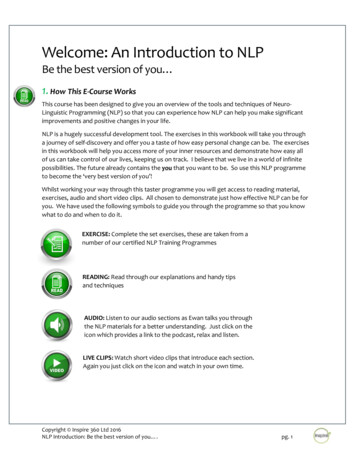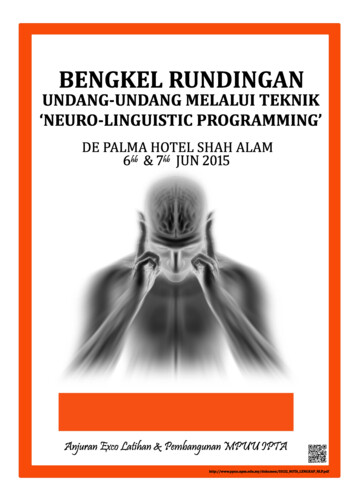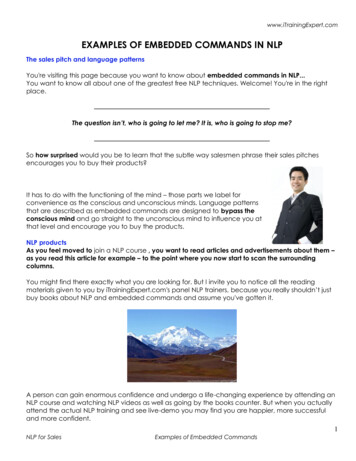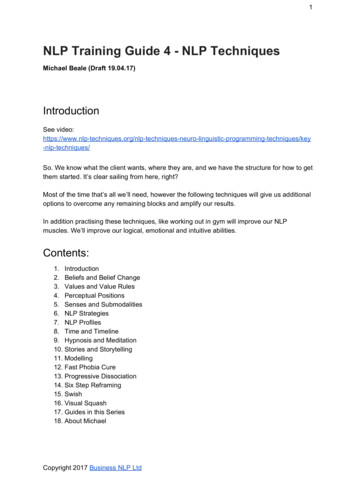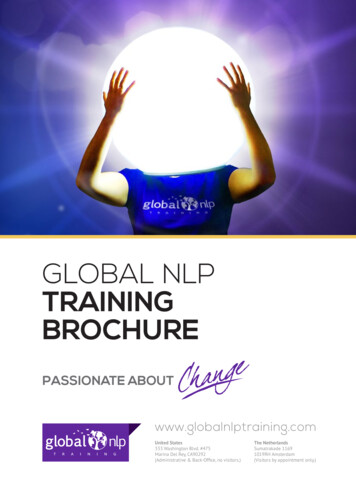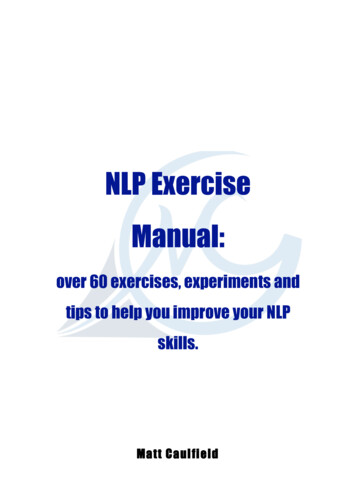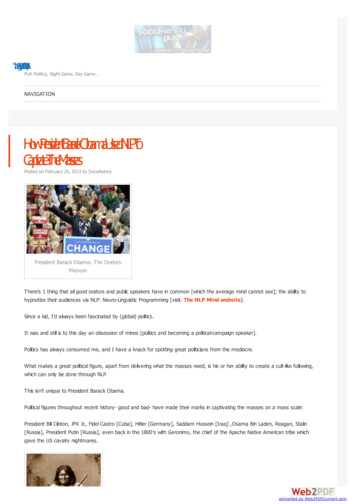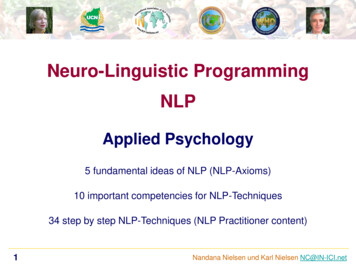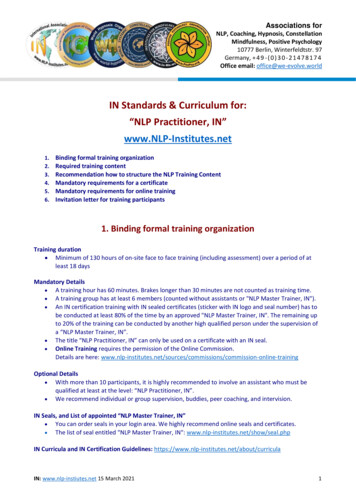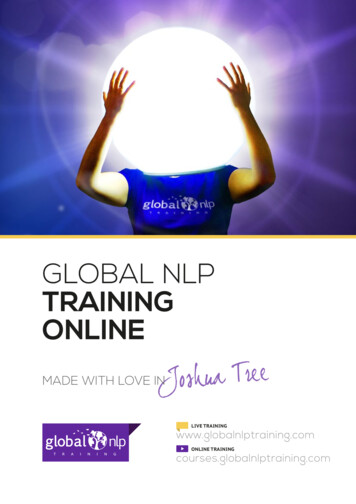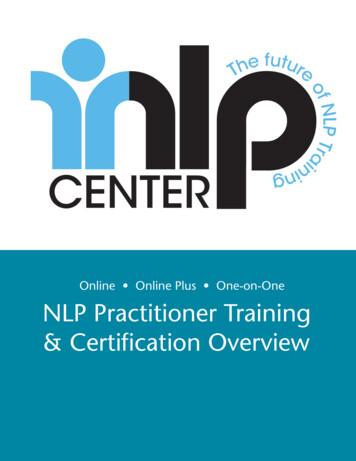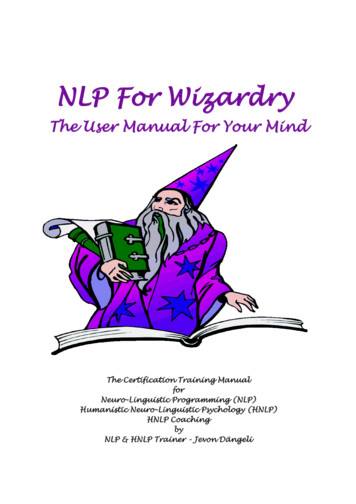
Transcription
NLP For WizardryThe User Manual For Your MindThe Certification Training ManualforNeuro-Linguistic Programming (NLP)Humanistic Neuro-Linguistic Psychology (HNLP)HNLP CoachingbyNLP & HNLP Trainer - Jevon Dängeli
TABLE OF CONTENTSTITLEPAGEAcknowledgements and LiabilityIntroductionPrefaceNLP Training VideosIntroducing Neuro-Linguistic Programming (NLP) (A)History of NLP56791012The Presuppositions of NLP (A)13NLP Communication ModelAnatomy of the Mind (A)Creating Excellence in your life202125Modeling26Sensory AcuityBMIRSEye AccessingEye Accessing ElicitationPrimary/Lead Representation System & SynaesthesiaRepresentational Systems - PredicatesRepresentational System Characteristics28293031323334Rapport36Perceptual PositionsWhen in doubt, go META (A)3740OutcomesThe Goal of Outcomes is to establish your Purpose (A)Successfully setting OutcomesOutcome questionsOutcome questions revisedState vs. Outcomes414247495051SubmodalitiesModalities - Submodalities- DriversSubmodalities check listHow to feel less intimidated or annoyed by someone (A)How to have more fun doing the things that aren t fun (A)Map acrossThe NLP Swish Pattern (explanation)Conquering Your Craving (A)The NLP Swish Pattern (original format)The NLP Swish Pattern - revisedBelief Change through Submodality ShiftsPhobia Model using Submodality ShiftsOvercoming Mental Obstacles (part 1) (A)52535456575859606162646566 Copyright 2012, Jevon Dängeli & John Overdurf 2
Overcoming Mental Obstacles (part 2) (A)Overcoming Mental Obstacles (part 3) (A)Overcoming Mental Obstacles (part 4) (A)687071LanguagingAbout NLP language skillsLinguistic Presuppositions (short form)Linguistic PresuppositionsLinguistic Presuppositions ExerciseThe Milton Model (short form)The Milton ModelThe Meta Model (short form)The Meta ModelHierarchy of Ideas/Logical Levels of AbstractionChunking Questions to change Logical LevelsHow to let go of limiting beliefs (and unwanted behaviours) LP NotationStrategiesStructural Well-formedness ConditionsTips for effective Strategiy elicitationFormal Strategy ElicitationElicitation QuestionsTypical Problems with Decision StrategiesMotivation StrategiesSpelling StrategiesWell-formedness Conditions for learning strategies - short formWell-formedness Conditions for learning strategies - short formWell-formedness Conditions elitication questions for learning strategiesRecovery Strategy future pacing to build ingWhent to use AnchoringHow to anchor resourceful states (A)Establishing a kinaesthetic AnchorBasic options for the use of Anchoring - short formBasic options for the use of AnchoringCollapse Anchor Outline- short formCollapse Anchor OutlineChaining Anchors: Chain DesignChaining Anchors: Chain InstallationVisual-kinaesthetic Dissociation - short formVisual-kinaesthetic DissociationHow to change your personal history (A)Change Personal History - original formatRe–imprint 5ReframingContext & Meaning ReframingSix-step ReframeAgreement FrameParts Integration (A)126127128130131 Copyright 2012, Jevon Dängeli & John Overdurf 3
Visual SquashMetaphor132133HUMANISTIC NEURO-LINGUISTIC PSYCHOLOGY HNLP: Definition of HNLP (A)Quantum Theory in NLP (A)HNLP Basic PresuppositionsThe 4 HNLP keys to maintaining Empowered Performance (A)HNLP: The Quantum Perceptual PositionsHNLP: Perceptual Position ReframeHNLP: Changing Perspectives with Neuro-DriversHNLP: Get ahead of your past programmingHNLP: The Relationship Resolution ProcessHNLP: The Problem DissolverHow to make BIG decisions small (A)The Worry Buster (A)HNLP S.E.T. GoalsHNLP: Dream Incubation ProcedureHow to switch your brain into success mode (A)Getting Motivated & Staying Motivated (A)Your Reality Check (A)Get over FEAR (A)Laugh away your fears 9160161163164SupplementsInterview Overview and ChangeworkRecommmended review schedule for easy long-term memory storageNLP Practitioner ReviewCertification Standards165166168169171HNLP Coaching Beyond GoalsOptimal Beliefs for Coaching Clients.and YourselfHNLP CoachingSetting Your State: The Optimal Coaching StateFormatting the Unconscious Mind in Conversational CoachingHNLP Breakthrough ModelStalking the Wild SynaesthesiaHNLP Coaching: Basic Conversational Change ModelHow to activate the power of your Unconscious Mind to achieve your goalsBeyond Goals (A)HNLP Coaching Model (procedure)The Next Step! (series 1-7) e Coaching SkillsHow to ask powerful Coaching questionsHow to ask the Big Questions 1 and 2 (A)Roles of the Coach and the clientLogical Levels of AlignmentNLP/HNLP Coach Practitioner Training "Warm-Up" ExcercisesJevon Dängeli Coaching Terms and Agreement (example)Recommended ReadingAbout the author208209211212215216217221223226 Copyright 2012, Jevon Dängeli & John Overdurf 4
AcknowledgementsThank you to my clients and all those who have attended our courses over the years.Without you I wouldn't have gained the necessary experience that has allowed me toexpand on the original content of the NLP & HNLP Practitioner training manual tocreate NLP For Wizardry - The User Manual For Your Mind.Thank you to John Overdurf for being my trainer and coach, and for allowing me toinclude content from his NLP & HNLP Practitioner training manual.Thank you to Jana Allmrodt for being the support structure at all our courses andbetween courses, and for editing NLP For Wizardry - The User Manual For YourMind.Jevon Dangeli - August, 2012LiabilityUsing any of the information and skills provided in this manual is the responsibility ofthose who use it.While this content is intended to only be of positive, empowering and healing value,Jevon Dangeli cannot be held responsible for any negative consequences that mayresult from reading or using any of the contents included in this manual.By reading or applying any part of this manual, you agree to use this materialethically and responsibly. Copyright 2012, Jevon Dängeli & John Overdurf 5
INTRODUCTION'In oneself lies the whole world,and if you know how to look and learn,then the door is there and the key is in your hand.Nobody on earth can give you either that key or the door to open,except yourself."- J. Krishnamurti - Copyright 2012, Jevon Dängeli & John Overdurf 6
PrefaceThese days any gadget comes with a comprehensive user manual in multiplelanguages, so here is your personal user manual for optimal functioning in this dayand age.In these high-tech and fast pace times, humans have become more complex thanever before. Greater complexity is probably useful in order to survive and to thrive inthe modern world, but therein lies the challenge for many people today. Morecomplex lifestyles have given rise to more complex challenges, resulting in morecomplications in life.The solutions to yesterday's complications are not as useful today.People need a way of lifting themselves above the smoke clouds that have beencaused by their own mental exhaust fumes. The thinking that created our brain smogis not the kind of thought process that can be used to clear it. A new paradigm ofthought is required. Skills to transcend our normal thought patterns are necessary ifwe want to uplift ourselves to new levels of joy, creativity and productivity.If we don't take control of our minds now, then there's no telling where we might landup, and the result may be a life lived like a child in a dark room - clumsy and fearful.Showing that child where the light switch is, how to switch it on, as well as how toenjoy things more both inside and outside that room is what this manual is about.NLP For Wizardry - The User Manual For Your Mind provides you with the knowledgeof how your mind works, the skills to take control of your mental and emotionalprocesses, and the ability to perform the kinds of actions that lead with greater easeto the results that you want.This resource is for anyone who wants to learn Neuro-Linguistic Programming (NLP)& Humanistic Neuro-Linguistic Psychology (HNLP) for the purpose of enhancingtheir personal and professional effectiveness. It includes simple and clearexplanations (in article form) of how a large variety of NLP & HNLP processes can beapplied to everyday life.The articles are written in such a way that they teach how the NLP & HNLPmethodologies can be used to overcome typical challenges in life. These articlesserve as examples of how the different techniques and processes can be applied inpractical ways. The articles are placed throughout the manual in the various sectionsthat are relevant to their content. These comprehensive explanations can be easilyfound as they are referenced with (A) alongside their titles in this manual's table ofcontents. Copyright 2012, Jevon Dängeli & John Overdurf 7
This manual also includes the full NLP & HNLP Practitioner training syllabus thatparticipants on our NLP & HNLP certification courses use as one of their primarytheoretical references. The NLP & HNLP techniques which appear in point form onlyare explained in detail with demonstrations and supervised practice at our livecertification courses, some of which are covered in our NLP Training video series.Whether you're using NLP For Wizardry - The User Manual For Your Mind forpersonal growth or as part of your formal NLP & HNLP training, you'll discover abroad range of practical and powerful methodologies to maximize you potential in allareas of your life.It's my passion and purpose to share these resources with you. I know they willenable you to get more out of yourself and more out of life. Like any skill, theirapplication proves their effectiveness, so use them, and discover the difference thatmakes the difference all for yourself.Jevon Dangeli - Certified NLP & HNLP Trainer Copyright 2012, Jevon Dängeli & John Overdurf 8
NLP Training Videos- The perfect companion to this manual Jevon Dangeli and Jana Allmrodt have created a unique, comprehensive, module bymodule, professionally edited with diagrams and notes – NLP & HNLP Practitionertraining video series.Each video is followed by review questions to help you master the subject.See Jevon live in action from the comfort of your own home.Watch him demonstrate the power of NLP & HNLP, as well as provide explanationsand examples that you won't get from this manual. You will hear Jevon answercommon questions that his students ask.These NLP & HNLP Practitioner training videos are filmed at Jevon's live courses.You can watch, learn and benefit from Jevon's training as if you were in the room withhim.Using NLP For Wizardry - The User Manual For Your Mind along with watching the trainingvideos will provide you with a rich understanding of NLP & HNLP and an ability to use theseskills effectively.And.THE VIDEOS ARE FREE !!!Register for this free video series ng/ Copyright 2012, Jevon Dängeli & John Overdurf 9
IntroducingNeuro-Linguistic Programming (NLP)"The study of subjective experience."“NLP is an Attitude and a Methodology that leaves behind a trail of techniques.”- Richard BandlerThe Attitude:CuriosityWanton ExperimentationThe Methodology:Modeling – the extrication and replication of eleganceThe Question:How is it possible? – Possible in the world, possible for me only a question of“how”Neuro-Linguistic Programming (NLP) is a practical model of human behaviour that has, at itscore, specific interest in the patterns of behaviour that distinguish excellent performance fromaverage performance. The three letters in the acronym NLP refer to:Neuro relates to our nervous system where our behaviour, our thoughts, our feelings and thestate of our bodies reside.Linguistic implies that it is mainly language that enables us to both internally store our innerexperiences as well as share them with the outer world. It is through language that we createour map of reality.Programming is the ability to change behaviour patterns and feelings in such a way thatthey become useful and constructive to our personality as a whole, thus fostering our growthand health.NLP is widely known as “the fastest and most powerful vehicle for personal change inexistence!” (Psychology Today Magazine)NLP was originated by Dr. John Grinder (whose background was in linguistics) and Dr.Richard Bandler (whose background was in mathematics and gestalt therapy) for thepurpose of making explicit models of human excellence. I.E what skills and techniques wouldhelp a person overcome a problem.They identified the verbal and behavioral patterns of therapists Fritz Perls (the creator ofgestalt therapy) and Virginia Satir (internationally renowned family therapist) and latermodelled Milton Erickson, founder of the American Society of Clinical Hypnosis and one ofthe most widely acknowledged and clinically successful psychiatrists of our time. They Copyright 2012, Jevon Dängeli & John Overdurf 10
studied Erickson’s ways to use metaphor and stories to induce trance as well as to help hisclients overcome their challenges.Grinder and Bandler formalized their modeling techniques and their own individualcontributions under the name “Neuro-Linguistic Programming” to symbolize the relationshipbetween the brain, language and the body.Through the years, NLP has developed some very powerful techniques and processes thatare used widely today in various fields to enhance performance, overcome negativeemotions and limiting beliefs, facilitate healing and improve relationships.“NLP could be the most important synthesis of knowledge about humancommunication to emerge since the explosion of Humanistic Psychology in thesixties” -Science Digest- Copyright 2012, Jevon Dängeli & John Overdurf 11
HISTORY OF NLPRevised January 1990 Tad James & Advanced Neuro DynamicsHistory of NLP Revised 1997 Neuro Energetics Copyright 2012, Jevon Dängeli & John Overdurf 12
The Presuppositions of NLPNLP Presuppositions form the basic beliefs and attitudes that effective NLPPractitioners work and live by. The 14 presuppositions below are the centralprinciples of NLP. They form a set of ethical principles for life.1. The map is not the territory.People represent the world internally to create their own personal and subjectiverealities. We respond mainly to our internal experience (map of reality), not to theexternal reality itself (see NLP Communication Model diagram - six pages ahead).How we represent things in our mind are our interpretations. Interpretations may ormay not be accurate. In any case, these interpretations determine how weexperience each moment, and therefore lay the foundation for our experience ofreality in the future too.Having choices about how to interpret your reality now, changes your experience ofit. And having more choices available to you begins by choosing to interpret eachexperience in a way that frees your thinking to explore different points of view. So,how else can you look at your situation, and how else, and how else? In this wayyour map of reality expands.2. We respect each person’s model of the world.We could sum it as “we respect each other”. Just because someone else has adifferent point of view (map of reality), it doesn’t mean that they are wrong and yourare right.3. Aim to increase choice.By aiming to increase choice, you’re choosing expand your map of reality. Expandyour map to one that gives you the widest and richest number of choices. The morechoices you have, the freer you are and the more influence you have over yourselfand others.Greater choice comes from being able to change your perceptual position. The 3main perceptual positions in NLP are:1. Associated to self. In your body, looking at the situation from your point ofview. Copyright 2012, Jevon Dängeli & John Overdurf 13
2. Associated to other. Taking the other person’s frame of reference.3. Associated to the “observer” or “witness”. Taking the the meta or objectiveperspective. Being the “fly on the wall”.Familiarising yourself with being in all 3 perceptual positions and becomingcomfortable doing so in all contexts broadens your scope of choice.With practice one can assume multiple perceptual positions simultaneously. With thatcomes the freedom to more consciously choose your thoughts, feelings and actionsin all types of situations.4. People make the best choice they can at the time.A person always makes the best choice they can, given their map of reality at thetime. The choice may be self-defeating, bizarre or evil, but for them, it seems the bestway forward. Give them a better choice in their map of reality and they will take it.Even better – help them upgrade their map to one with more choices in it.Another way of putting this is: We all act according to the level of awareness that’savailable to us in that moment. The reason why people regret certain past actions isbecause they have greater awareness now, and because of this phenomena, theyeventually overcome their current regret too.Based on the premise of this presupposition, whoever caused us pain in the past, didso based on their level of awareness at that time. They were trying to fulfil a certainvalue in their old map of reality and never knew how else to go about it back then.Looking back on that past hurt from a broader and resourceful perspective in thepresent can enable healing and release of stuck emotions.Therefore, the broader our perspectives now, the more choices we have – in thepast, present and future 5. People work perfectly.No one is wrong or broken. People function perfectly even if what they are doing isruining their life. All behaviour has a structure. When you understand the structure,you can change the behaviour into something more desirable.People carry out their behavioural strategies perfectly, but the strategies may bepoorly designed and ineffective. Finding out how you or others do what you or theydo, enables you or them to change the ineffective strategy to one that is more suitedto achieving useful and desirable results. Copyright 2012, Jevon Dängeli & John Overdurf 14
6. All actions have a purpose.Our actions are not random; we are always trying to achieve something, although wemay not be aware of what that is.Behind each behaviour there is a positive intention. This may be the anticipation ofpleasure or avoidance of pain. People want to achieve something that they value andwhich benefits them.NLP separates the intention or purpose behind an action from the action itself. Aperson is not their behaviour. When a person has a better choice of behaviour thatalso achieves their positive intention, they will take it.When the behaviour is undesired, find alternate ways to achieve the behaviour’spositive intent. Seek to add choices and resources. When you take away choices,other compensating behaviours can occur.Internal conflicts, indecision, procrastination and lack of motivation are often theresult of conflicting values in our unconscious awareness. Establishing the highestintention or purpose of each conflicting value enables integration and inner alignmentwhich results in greater choice and freedom.To change unwanted behaviours, start by eliciting the highest positive intention whichdrives that behaviour, then seek to satisfy that intention through more appropriatemeans.In order to be more understanding and compassionate towards others, seek toestablish what their highest positive intentions are.We act according you our current level of awareness. By bringing the underlyingpurpose of particular actions into awareness, we create more possibilities forourselves and our clients.7. The meaning of your communication is not simply what you intend, but alsothe response you get.Resistance in others indicates a lack of rapport, or that the other person doesn’t getyour meaning. We all resist when we don’t understand. Your intended communicationis not always what is perceived.You cannot not communicate. We are always communicating either verbally or nonverbally. Even the absence of a response is information. Each person deletes,distorts and generalizes pure sensory information (input through the senses). Ournervous system is conditioned to filter information in this way. These filters aretriggered by both verbal and non-verbal behaviours in others. Copyright 2012, Jevon Dängeli & John Overdurf 15
Which is more important: What you intend to communicate, or what you actuallycommunicate? Flexible communicators change what they’re saying (and how they’resaying it, as well as their body language) until their desired results are obtained.8. We already have all the resources we need, or we can create them.You already have it in you. Everything a person needs to effect a positive change isalready in them. They may, however, not be consciously aware of it. Often peoplehave resources that they haven’t considered or are available in other contexts.Resources mean the internal responses and external behaviours needed to getdesired results. Our most basic resource is our ability to learn.There are no unresourceful people, only unresourceful states of mind. As responseable people, we can run our own mind and therefore move toward getting the resultsthat we want. The key to achieving this is through knowing how to change your state,as specific resources are accessed only through being in the appropriate state.States are the keys that either open or lock the door to the infinite reservoir ofresources inside you.Appropriate states are those that match the kind of resources that you would like togain access to. For example, to be in a confident state shift your body posture, breathand internal dialogue to that which matches confidence. You will immediately begin tofeel more confident.In the above way you can, through changing you body posture, breath and internaldialogue, assume any state. Through assuming appropriate states, your thinkingbecomes clear, new creative choices arise into awareness, and empowered actionsare the result.Conversely, we’ve all had the experience of being in a miserable state, and you knowhow resourceful you felt then!The hypnotic state is highly versatile state, since it’s often referred to as the “masterkey” to your inner resources. Hypnosis enables people to have direct contact with thelevel of their awareness that’s usually unconscious. Hypnotherapy leverages thehypnotic state for the purpose of healing.So, which ever way you choose to go about it, states are the way in which you tapyour inner wisdom and productive levels of thought to deal effectively with anysituation. Copyright 2012, Jevon Dängeli & John Overdurf 16
9. Mind and Body are connected, and form a system.It’s clear how the mind-and-body affect each other: Prolonged stress or heavyemotional spells often result in physical sickness. Likewise, positive attitudes, joy andlaughter are not only healing for the body, but also help prevent sickness.NLP eye patterns reveal our internal sensory processing. Some of the otherphysiological cues that indicate our mental processes are posture, speech andbreathing rate. Since physiological cues reflect the functioning of your mind, bychanging particular physiological cues you can affect the functioning of your mind.For example, slumping in your chair can make you feel tired, or taking a walk canuplift your thoughts.Mind and body interact and mutually influence each other. It is not possible to make achange in one without the other being affected. When we think differently, our bodieschange. When we act differently we change our thoughts and feelings.Treating only mental/emotional or physical symptoms without taking responsibility forthe underlying reasons why such symptoms have manifested, may disrupt themind/body system. Ignoring the subtle causes of unwanted symptoms can result inmore complex complications later. For example, regularly taking sleeping tablets toget enough sleep at night, without addressing the mental/emotional causes (likestress or dissatisfaction) of not being able to sleep, may lead to burn out and/ordisease.Consciousness expresses itself through the system of your mind and body. Mind andbody are therefore intimately linked, and ultimately, they’re two aspects of the samesource. Any healing program must aim to optimize the flow and balance ofconsciousness in both the mind and body in order for healing to be effective andcomplete.10. There is no such thing as failure, there is only feedback.Legend has it that prior to Thomas Edison inventing the light bulb, he wasinterrogated by a probing journalist who demanded to know why Edison had failedsomething like 200 times to invent the light bulb that Edison claimed was animminent reality. Edison s reply went along the lines that he hadn’t failed to invent thelight bulb 200 times, instead, he’d discovered 200 ways not to invent it.With that kind of attitude, Edison was quite likely able to maintain a resourceful stateand be positively motivated to persevere until his goal was reached.The attitude that we bring to a situation determines our response to that situation. Copyright 2012, Jevon Dängeli & John Overdurf 17
Every result gives you feedback, maybe information about how to do somethingdifferently next time. Feedback is helpful and sets direction. This kind of attitudetoward “failure” produces results that allow you to improve. Results are the means bywhich you measure your progress and adjust your behaviour in order to achieve yourdesired outcomes.Every experience offers a positive learning, one from which we can grow intellectuallyor in terms of emotional intelligence. Living is learning, even if you loose, you don’tloose the learning.11. The person or element with the most flexibility in a group or system willhave the most influence.This is the Law of requisite variety from systems theory. It means the person with themost options and behavioural choices will control the system. In any field, the toppeople in that field are those who have the most variety in their behaviour. They havechoices of behaviour that their colleagues don’t. Any time you limit your behaviouralchoices you give others the competitive edge. If you’re able to respond to anysituation in a variety of ways, you are more likely to get your outcome.12. Modeling successful performance leads to excellence.No matter how you define success, many successful people have got to where theyare through modelling the successful performance of others.Modeling is not copying. Copying how someone became successful in the 80s isunlikely going to make you successful today. Modelling in NLP is the process ofidentifying and replicating both the conscious and unsconscious competence inanother, which results in that person’s excellence.Unconscious competence (what we do effortlessly, without conscious awareness)can be identified through careful observation, questioning and strategy elicitation.Once you know the thoughts, beliefs, values and behaviours that result in excellence,you can test the model and refine it to fit with you. Once you’re able to replicate thesame degree of success in a specific context, you’ve got that model.If it’s possible for someone else, it’s possible for you, and teachable to others(provided they don’t have severe physiological or neurological damage). In this waymost people can learn to get better results in their own way, you do not become aclone of the model – you learn from them.Find a model of excellence in a field that you’re interested in. Identify the sequence ofcomponents (thoughts, beliefs, values and behaviours) that are necessary to achieve Copyright 2012, Jevon Dängeli & John Overdurf 18
the desired result. Apply that model in a way that enables you to get the same kindsof results, and success is yours.13. All processes should lead to integration and wholeness.Many of our personal issues and challenges in life are the result of parts of ourunconscious mind becoming dissociated from the flow of neural information that’savailable to our whole Self. This essentially leads to the formation of subpersonalities in our unconscious awareness, each one essentially with its own valuessystem. All unwanted behaviours that we have little or no conscious control over aredriven by parts. Conflicting parts are also the cause of indecision and procrastination.Integrating parts is therefore an important part of most coaching and therapysessions.In NLP, a variety of methods have been developed to integrate parts, includingfinding new solutions for a parts using the Six Step Reframing technique, andcreating oneness between two or more parts using the Parts Integration or VisualSquash technique.14. If you want to understand – ActReal learning is in the doing. Through application you will soon discover what worksand what doesn’t work. Keep doing (and refining) the things that get you the resultsthat you want. Remember, there is no failure, only feedback. Copyright 2012, Jevon Dängeli & John Overdurf 19
NLP COMMUNICATION MODELNLP Communication Model 1992 Neuro-Energetics & Advanced Neuro Dynamics Copyright 2012, Jevon Dängeli & John Overdurf 20
ANATOMY OF THE MINDTHE CONSCIOUS MIND & UNCONSCIOUS MINDYou only have one mind, but there are two main faculties or realms of consciousnessthat make up your personal mind. These are refereed to as the "conscious mind" andthe "unconscious or subconscious mind".One of the keys to living life the way you want is understanding how your mind reallyworks. Let's start with the basics:Your conscious mind is that of which you are currently aware. For example, you areprobably aware of listening to my voice, hearing my words. You might be aware ofcertain thoughts that you are having right now. Perhaps you are aware of backgroundsounds in the area where you’re sitting. Perhaps you are aware of the feeling of yourbody against the surface on which yo
NLP Training Videos 9 Introducing Neuro-Linguistic Programming (NLP) (A) 10 History of NLP 12 The Presuppositions of NLP (A) 13 NLP Communication Model 20 Anatomy of the Mind (A) 21 Creating Excellence in your life 25 Modeling 26 Sensory Acuity 28 BMIRS 29 Eye Accessing 30 Eye Access
